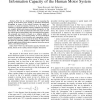HCI
2011
13 years 3 months ago
2011
HCI
2011
13 years 3 months ago
2011
Abstract. Brain computer interfaces (BCI) that use the steady-statevisual-evoked-potential (SSVEP) as neural source, offer two main advantages over other types of BCIs: shorter ca...
HCI
2011
13 years 3 months ago
2011
Over the past 15 years, children have become more integrally involved in the design of their technology. In this paper, we present the idea that design partnering methods, specific...
HCI
2011
13 years 3 months ago
2011
Almost 20% of big earthquakes in the world occur in Japan. It becomes impossible for private companies and governments to carry out their business if they suffer from severe damage...
HCI
2011
13 years 3 months ago
2011
HCI
2011
13 years 3 months ago
2011
We studied communication patterns in face-to-face dialogues between people for the purpose of identifying conversation features that can be exploited to improve human-computer inte...
HCI
2011
13 years 3 months ago
2011
The search for new simplified interaction techniques is mainly motivated by the improvements of the communication with interactive devices. In this paper, we present an interactiv...
FGR
2011
IEEE
13 years 3 months ago
2011
IEEE
Abstract— We propose a system for human computer interaction via 3D hand movements, based on a combination of visual tracking and a cheap, off-the-shelf, accelerometer. We use a ...
CSCW
2011
ACM
13 years 4 months ago
2011
ACM
This ethnographic study of 22 diverse families in the San Francisco Bay Area explores parents’ attitudes about their children’s use of technology. We found that parents from d...
CORR
2011
Springer
13 years 4 months ago
2011
Springer
—Fitts’ law is a fundamental tool in measuring the capacity of the human motor system. It measures information throughput in terms of the tradeoff between the speed and accurac...



